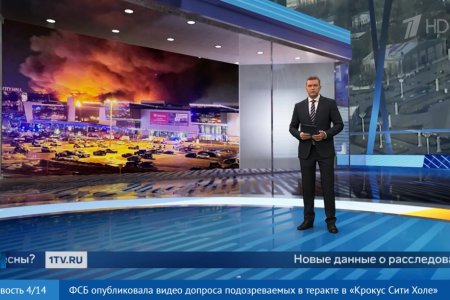
Russian propagandists are actively flogging a deepfake video, first posted by the propaganda NTV channel, which implies that Ukraine was behind the terrorist attack on the Crocus City Hall Centre on 22 March. Although it is not difficult to see that the video is a fake, a spokesman for Ukraine’s Military Intelligence [HUR] has pointed to signs that it was prepared in advance. That would raise chilling questions, especially given the failure by the FSB to thwart an actual crime, one to which western intelligence had tried to alert them.
Ukraine’s Centre for Countering Disinformation, attached to the National Defence and Security Council [NDSC] reported the video on 23 March, pointing out that the fake had been produced, using shots from the Ukrainian TV Marathon on 16 March, while claiming that Oleksiy Danilov had been interviewed there on the evening of the attack. Danilov is supposed to say the following: “Is it fun in Moscow today?. I’d say it’s a lot of fun, and would like to believe that we will organize such fun for them more often”. The Centre is scathing about the low quality of the video, noting that Danilov’s motions and words are out of sync.
The fact that this was a fake was first reported by Meduza shortly after it was shown on NTV around 1 a.m. The NTV presenter made the intended message quite clear, prefacing the video with the claim that Oleksiy Danilov had confirmed “the involvement of the Kyiv regime in the Moscow region terrorist attack.”
There was no such ‘interview’, with both different guests on the 22 March TV Marathon, and different presenters. There was, therefore, no Ukrainian admission of involvement’, yet while western media also confirmed the video to be a fake, Russia’s propagandists treated it as a genuine interview and as an excuse to call for more attacks on Ukraine. None of this made any sense, especially after the Islamic State had said that they were behind the attack, but the claims continued regardless.
It is just possible that the propagandists simply know which way the wind is blowing and understood that the regime would seek to use the attack to intensify its war against Ukraine. It seems just as likely that they received instructions on the line to be taken, especially given that NTV (and other state TV channels) were silent about the attack for hours, continuing their normal Friday evening schedule. This was in marked contrast to the extensive coverage the unfolding events were receiving outside Russia.
Andriy Yusov, a representative of Ukraine’s Military Intelligence, has told Detector Media that there are grounds for believing that the video was prepared in advance. He points to the fact that an old broadcast (from 16 March) was used, as well as to what he calls the fairly high-quality graphic production. Soon after the attack began on Friday evening, Yusov called it an attack planned in advance by Russia’s security service. He asserted that the international community had been aware of the Kremlin’s plans.
Whether the latter assertion is true may be in dispute, but it is certainly true that the USA, UK, and several other countries warned their nationals about a likely terrorist attack in Moscow around two weeks earlier. The USA has now confirmed that they also transmitted those warnings to the authorities in Russia. Russian leader Vladimir Putin publicly dismissed such warnings and tried on 23 March to push the narrative about Kyiv’s involvement, asserting that the four alleged terrorists had been seized while seeking to flee to Ukraine. This was totally implausible and swiftly exposed, perhaps inadvertently, by the Belarusian regime which claimed credit for catching the alleged terrorists as they tried to cross into Belarus.
Dmitry Medvedev, deputy head of Russia’s Security Council, had immediately suggested that the “Kyiv regime” might be responsible, and the claims on propaganda television, as well as those from Putin do suggest that this is the narrative that is to be followed, regardless of the facts.
So is this opportunism, in the face of massive failings by the FSB and authorities, or something much more sinister?
Even if the Kremlin publicly dismissed warnings from western countries, heightened security measures would still have been warranted. There were clearly none in place, with four terrorists having no difficulty in bursting into a concert hall with machine guns, stocks of ammunition and incendiary devices. Not only had measures to prevent such terrorist attacks not been taken, but basic safety requirements were not in place, with many of the survivors reporting that all of the emergency exits proved to be locked.
The fact that the FSB took an hour and a half to arrive at the scene, and that no attempts were, reportedly, made to put out the fire until then, may point to incompetence, and not reluctance to find incriminating evidence. Perhaps the four actual terrorists, who fled the scene, are the four men whose capture was announced, and the seven other people seized are legitimately suspected of involvement in the attack. The FSB’s methods, in particular their reliance on horrific torture, are, however, notorious, and there are certainly a lot of questions. Under the current regime, however, the FSB have every reason to believe that the questions will not be asked, and that they will continue to enjoy impunity.



